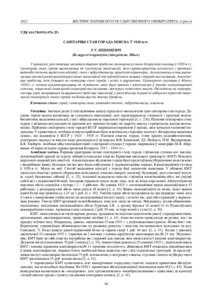Please use this identifier to cite or link to this item:
https://elib.psu.by/handle/123456789/28987| Title: | Санітарны стан горада Мінска ў 1920-я гг. |
| Authors: | Пецюкевіч, Т. У. Petsiukevich, T. |
| Other Titles: | The Sanitary Condition of the City of Minsk in the 1920s |
| Issue Date: | 2022 |
| Publisher: | Полоцкий государственный университет |
| Citation: | Пецюкевіч, Т. У. Санітарны стан горада Мінска ў 1920-я гг. / Т. У. Пецюкевіч // Вестник Полоцкого государственного университета. Серия A, Гуманитарные науки. - 2022. - № 1. – С. 50-53. |
| Abstract: | У артыкуле разглядаецца маладаследаваная праблема санітарнага стану беларускай сталіцы ў 1920-я гг. Санітарны стан горада вызначаецца як сукупнасць паказчыкаў, якія характарызуюць тэхналогіі і практыкі водазабеспячэння, выдалення адходаў, стан і забруджанасць гарадской тэрыторыі. Актуальнасць тэмы вызначаецца значнай роляй вышэйпералічаных паказчыкаў для паўсядзённага жыцця і здароўя насельніцтва. Аналізуюцца праблемы, якія ўплывалі на санітарны стан горада, і шляхі іх вырашэння. Санітарную сітуацыю ў Мінску 1920-х гг. можна ахарактарызаваць як складаную, што было звязана з адсутнасцю ў горадзе каналізацыйнай сістэмы, невысокай санітарнай культурай насельніцтва і вострым недахопам жылля. Нягледзячы на мерапрыемствы ўлад, накіраваныя на вырашэнне дадзеных пытанняў, у разглядаемы перыяд не адбылося перахода паказчыкаў санітарнага стану горада на больш высокі якасны ўзровень.= The article deals with the little-studied problem of the sanitary condition of the Belarusian capital in the 1920s. The sanitary condition of the city is defined as a set of indicators characterizing the technologies and practices of water supply, waste disposal, the condition and pollution of the urban area. The relevance of the topic is determined by the significant role of the above indicators for the daily living conditions and health of the population. The problems that had an impact on the sanitary condition of the city and the ways to solve them are analyzed. The sanitary situation in Minsk in the 1920s can be defined as difficult, which was due to the lack of a sewer system in the city, a low sanitary culture of the population and an acute shortage of housing. Despite the measures taken by the authorities aimed at solving these issues, during the period under review there was no transition of indicators of the sanitary condition of the city to a higher quality. |
| URI: | https://elib.psu.by/handle/123456789/28987 |
| metadata.dc.rights: | open access |
| Appears in Collections: | 2022, № 1 |
Items in DSpace are protected by copyright, with all rights reserved, unless otherwise indicated.
